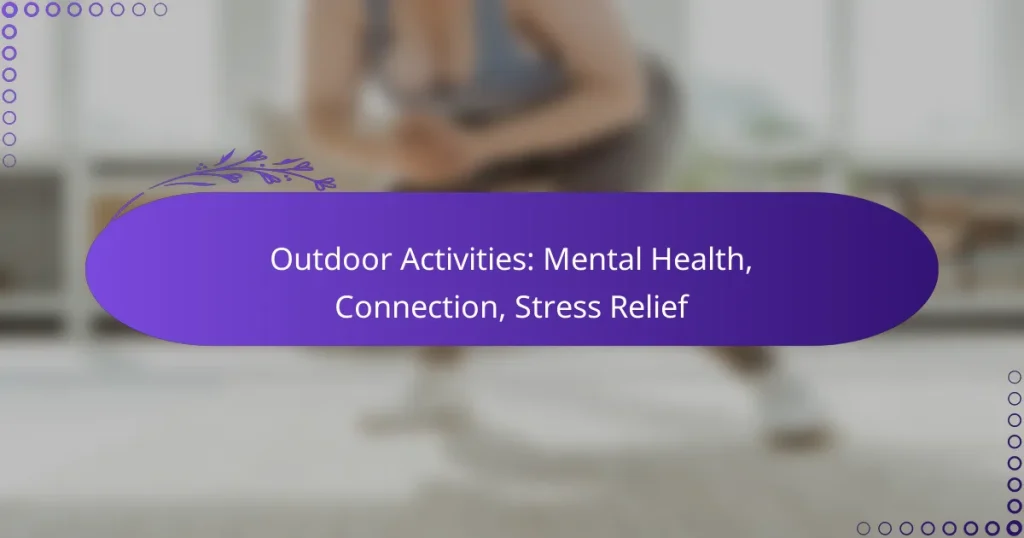Engaging in outdoor activities is a powerful way to boost mental health, offering benefits such as reduced stress and improved emotional well-being. Activities like hiking, yoga, and cycling not only promote physical fitness but also foster connections with nature and others, enhancing social interactions. By participating in these activities, individuals can experience a greater sense of community and relaxation, leading to a more balanced and fulfilling life.
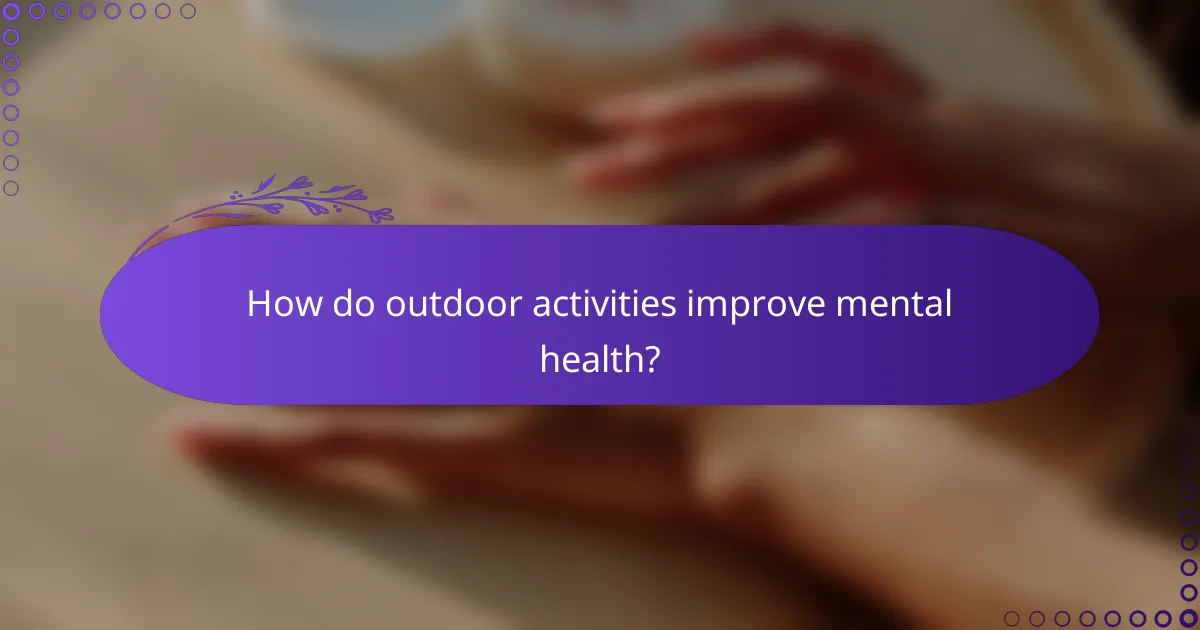
How do outdoor activities improve mental health?
Outdoor activities significantly enhance mental health by providing opportunities for physical exercise, social interaction, and exposure to nature. Engaging in these activities can lead to reduced stress levels and improved overall emotional well-being.
Reduces symptoms of anxiety
Participating in outdoor activities can help alleviate anxiety symptoms by promoting relaxation and reducing tension. Physical exercise releases endorphins, which are natural mood lifters that can counteract feelings of anxiety.
Activities such as hiking, cycling, or even walking in a park can serve as effective distractions from daily stressors. Regular engagement in these activities can lead to long-term reductions in anxiety levels.
Enhances mood and emotional well-being
Outdoor activities are linked to enhanced mood and emotional health due to their ability to increase physical activity and social interaction. Being in nature can elevate feelings of happiness and satisfaction.
Simple activities like gardening or playing sports with friends can foster a sense of community and belonging, which further contributes to emotional well-being. Aim for at least 30 minutes of outdoor activity several times a week to experience these benefits.
Boosts cognitive function
Engaging in outdoor activities can improve cognitive function by enhancing focus and creativity. Exposure to natural environments has been shown to increase attention spans and promote problem-solving skills.
Consider activities that challenge your mind, such as orienteering or nature photography, which require planning and observation. Regular outdoor engagement can lead to sharper cognitive abilities over time.
Promotes mindfulness and presence
Outdoor activities encourage mindfulness by allowing individuals to connect with their surroundings and be present in the moment. This connection to nature can help reduce rumination and promote a sense of peace.
Practices such as yoga in a park or mindful walking can enhance this experience. Aim to incorporate moments of stillness and observation during your outdoor activities to fully benefit from this mindfulness aspect.

What outdoor activities are best for stress relief?
Outdoor activities that promote stress relief include hiking, yoga, cycling, and gardening. These activities not only provide physical exercise but also enhance mental well-being by connecting individuals with nature and fostering social interactions.
Hiking in national parks
Hiking in national parks is an excellent way to relieve stress while enjoying breathtaking landscapes. The combination of physical activity and immersion in nature can significantly boost mood and reduce anxiety levels.
When hiking, consider choosing trails that match your fitness level. Many national parks offer a range of paths, from easy walks to challenging hikes. Always check weather conditions and park regulations before heading out.
Yoga in nature
Practicing yoga in natural settings combines physical movement with mindfulness, making it a powerful stress-relief tool. The tranquility of outdoor environments enhances the calming effects of yoga, promoting relaxation and mental clarity.
Look for local classes or groups that offer outdoor yoga sessions in parks or gardens. If you prefer to practice alone, find a quiet spot and bring a mat to enjoy the benefits of fresh air and natural surroundings.
Cycling through scenic routes
Cycling along scenic routes allows for both physical exercise and a chance to explore beautiful landscapes. This activity can elevate your mood and provide a sense of freedom, helping to alleviate stress.
Choose routes that are safe and suitable for your cycling skills. Many cities have dedicated bike paths or trails that offer stunning views. Remember to wear a helmet and follow local traffic regulations for a safe ride.
Gardening in community spaces
Gardening in community spaces fosters connection with others while providing a therapeutic outlet for stress relief. Engaging with plants and nature can improve mood and promote a sense of accomplishment.
Join a local community garden to meet like-minded individuals and share gardening responsibilities. If you’re new to gardening, start with easy-to-grow plants and gradually expand your skills. Regular participation can enhance both mental health and social bonds.
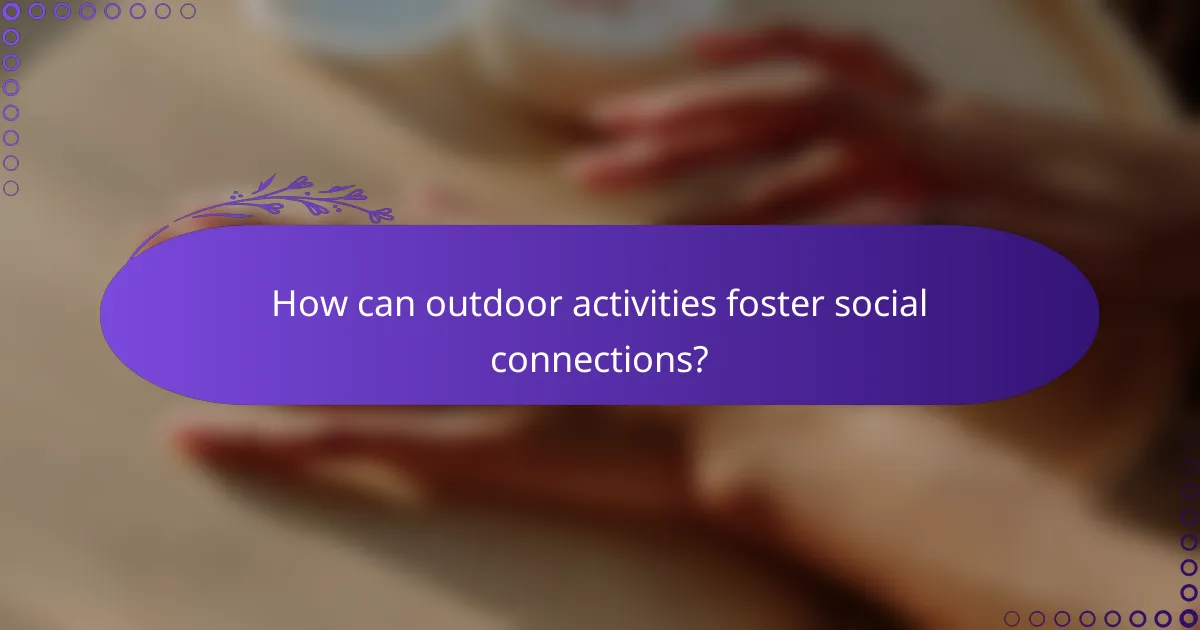
How can outdoor activities foster social connections?
Outdoor activities can significantly enhance social connections by providing opportunities for individuals to engage with others in a relaxed environment. Participating in group settings encourages communication, teamwork, and shared experiences, all of which strengthen bonds between participants.
Group sports and team activities
Group sports and team activities are excellent ways to build social connections while enjoying physical exercise. Joining a local soccer, basketball, or volleyball league not only promotes fitness but also fosters camaraderie among teammates. Regular practices and games create a sense of belonging and encourage friendships that often extend beyond the field.
Consider participating in recreational leagues that cater to various skill levels, ensuring everyone feels included. Many communities offer affordable options, making it accessible for all ages and backgrounds.
Outdoor fitness classes
Outdoor fitness classes, such as yoga in the park or boot camps, provide a supportive atmosphere for socializing while staying active. These classes often attract diverse groups, allowing participants to meet new people with similar health goals. Engaging in group workouts can motivate individuals to push their limits while forming connections with fellow fitness enthusiasts.
Look for classes that encourage interaction, such as partner exercises or group challenges, to enhance the social aspect. Many cities offer free or low-cost outdoor fitness programs, making it easy to join in.
Community volunteering events
Community volunteering events are a powerful way to connect with others while contributing to a cause. Activities like park clean-ups, tree planting, or local charity runs bring people together for a shared purpose, fostering a sense of community. Working alongside others towards a common goal can lead to meaningful relationships and a deeper sense of belonging.
Seek out local organizations that host regular volunteer opportunities. Engaging in these events not only helps the community but also allows you to meet like-minded individuals who share your values.
Adventure travel with friends
Adventure travel with friends can strengthen existing relationships and create lasting memories. Activities such as hiking, camping, or kayaking provide shared experiences that enhance bonds and encourage teamwork. Exploring new environments together can lead to deeper conversations and a greater appreciation for each other’s company.
When planning adventure trips, consider choosing destinations that offer a variety of activities to cater to different interests. This ensures everyone can participate and enjoy the experience, ultimately reinforcing social connections.
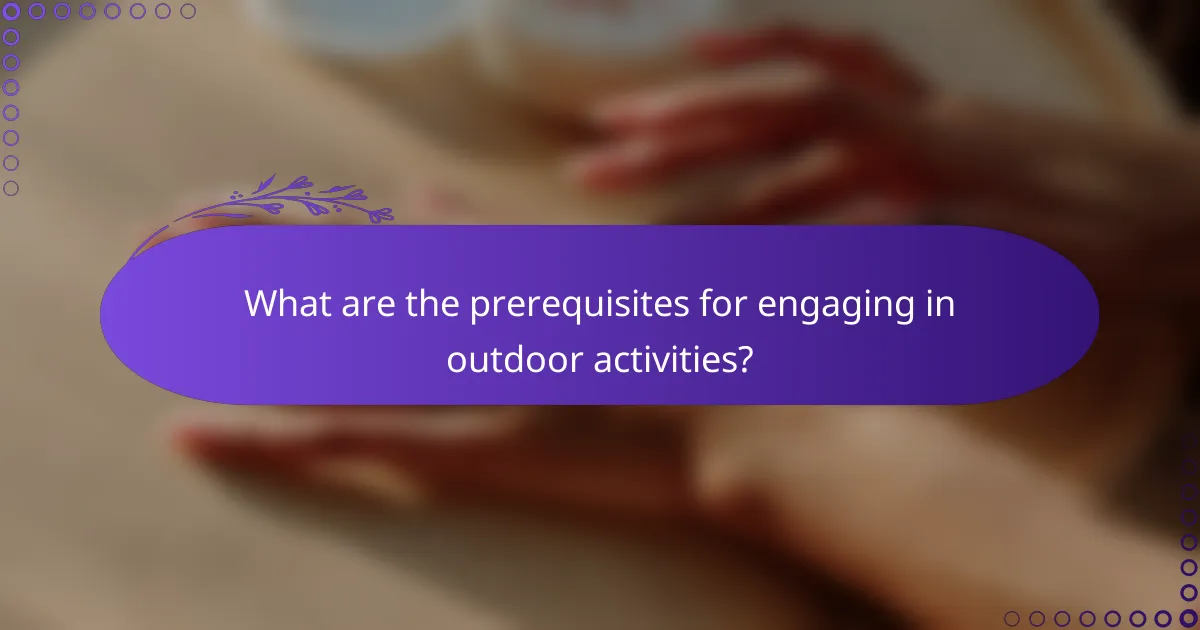
What are the prerequisites for engaging in outdoor activities?
Engaging in outdoor activities requires a few essential prerequisites to ensure safety and enjoyment. Key considerations include assessing your personal fitness levels, understanding local regulations, and choosing the right gear and equipment.
Assessing personal fitness levels
Before participating in outdoor activities, evaluate your physical fitness to match the demands of the activity. Activities like hiking or cycling may require different levels of endurance and strength, so consider your current fitness level and any health conditions.
A simple way to assess your fitness is to try a short walk or a light jog. If you struggle with these basic activities, it may be wise to start with less strenuous options and gradually build up your stamina.
Understanding local regulations and safety
Familiarize yourself with local regulations that govern outdoor activities in your area. This may include permits for camping, restrictions on certain trails, or guidelines for wildlife interactions. Ignoring these can lead to fines or unsafe situations.
Additionally, check for any safety advisories related to weather conditions or trail closures. Websites and local parks often provide updated information that can help you plan your activities safely.
Choosing appropriate gear and equipment
Selecting the right gear is crucial for a successful outdoor experience. Depending on the activity, this may include proper footwear, clothing suitable for the weather, and safety equipment like helmets or life jackets.
For example, if you’re hiking in a mountainous area, invest in sturdy hiking boots and a reliable backpack. Always ensure your gear is in good condition and appropriate for the specific environment you will encounter.
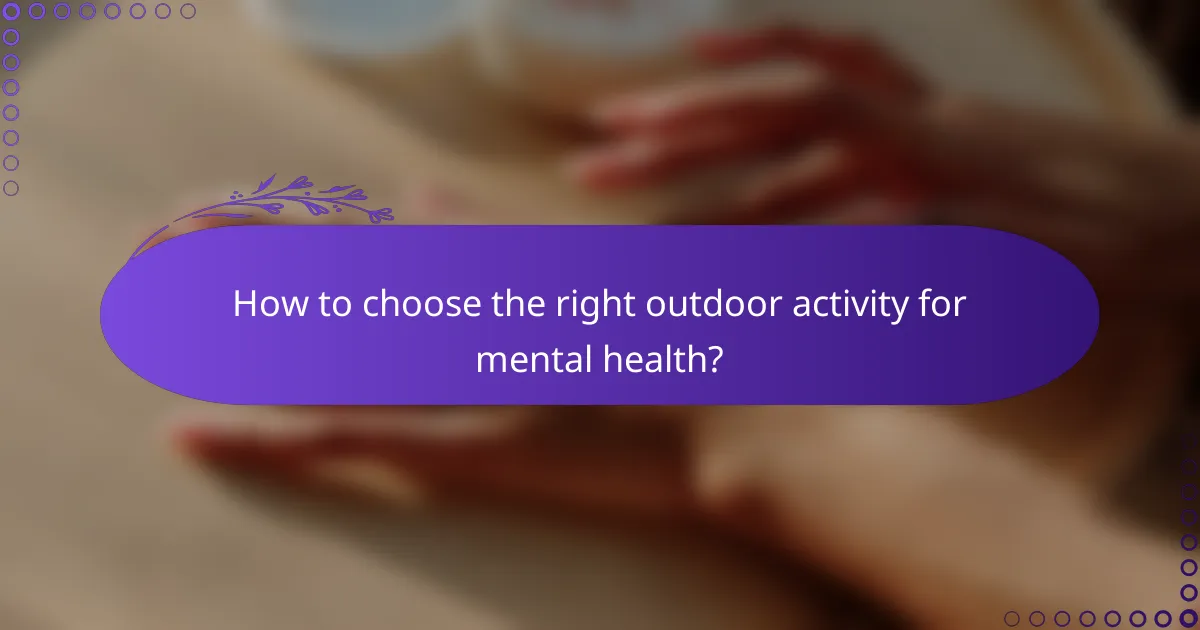
How to choose the right outdoor activity for mental health?
Selecting the right outdoor activity for mental health involves aligning your interests with accessible options that fit your schedule. Prioritize activities that resonate with you personally, are easy to reach, and can be integrated into your daily routine.
Identifying personal interests and preferences
Think about whether you prefer solitary activities, which can offer peace and reflection, or social ones that foster connection. Your choice should align with what makes you feel most fulfilled and relaxed.
Considering accessibility and location
Evaluate how easy it is to access potential outdoor activities. Look for parks, trails, or recreational areas near your home or workplace. Accessibility can significantly impact your likelihood of participating regularly.
Also, consider the safety and suitability of the locations. Ensure that the areas you choose are well-maintained and appropriate for your skill level to avoid frustration or injury.
Evaluating time commitment and scheduling
Assess how much time you can realistically dedicate to outdoor activities each week. Whether it’s a few hours on weekends or short daily sessions, find a balance that fits your lifestyle. Consistency is key for mental health benefits.
Plan your activities around your existing commitments. Setting specific times for outdoor pursuits can help you stick to your goals and make them a regular part of your routine.

What are the benefits of outdoor therapy programs?
Outdoor therapy programs offer numerous mental health benefits, including stress relief, improved mood, and enhanced social connections. Engaging in nature-based activities can significantly boost emotional well-being and foster a sense of community.
Improved Mental Health
Outdoor therapy programs can lead to substantial improvements in mental health by reducing symptoms of anxiety and depression. Nature exposure has been shown to lower cortisol levels, which helps alleviate stress and promotes relaxation.
Participating in these programs often involves physical activities like hiking or gardening, which release endorphins, further enhancing mood. Regular engagement can create a positive feedback loop, encouraging ongoing participation and mental resilience.
Enhanced Social Connections
These programs foster social interactions, which are crucial for emotional support and community building. Group activities in outdoor settings allow participants to bond over shared experiences, reducing feelings of isolation.
Building connections in a natural environment can be more effective than traditional therapy settings. Participants often find it easier to open up and share their feelings when surrounded by nature and peers, creating a supportive atmosphere.
Stress Relief
Outdoor therapy is particularly effective for stress relief, as nature has a calming effect on the mind. Activities such as walking in the woods or practicing mindfulness in a park can significantly lower stress levels.
Incorporating outdoor time into daily routines can be a simple yet powerful way to manage stress. Aim for at least 30 minutes of outdoor activity several times a week to experience these benefits fully.
